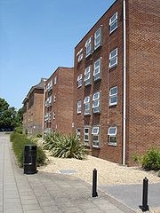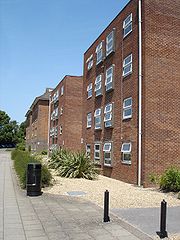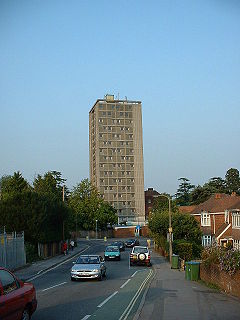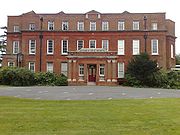
Wessex Lane Halls
Encyclopedia

University of Southampton
The University of Southampton is a British public university located in the city of Southampton, England, a member of the Russell Group. The origins of the university can be dated back to the founding of the Hartley Institution in 1862 by Henry Robertson Hartley. In 1902, the Institution developed...
. It is situated in the Swaythling
Swaythling
Swaythling was once a village but over the years it has gradually become a suburb and electoral ward of Southampton in Hampshire, England. The ward has a population of 13,394....
district of Southampton
Southampton
Southampton is the largest city in the county of Hampshire on the south coast of England, and is situated south-west of London and north-west of Portsmouth. Southampton is a major port and the closest city to the New Forest...
, approximately one mile north-east of the University campus in Highfield.
The complex is formed of South Stoneham House, Connaught Hall and Montefiore House. There are over 1800 undergraduate and postgraduate students living in Wessex Lane Halls.
The Halls operates a Wardenal system, where post graduate and mature students are employed to look after the halls and students. This group is often referred to as the Senior Common Room. The students organise their own social events, sports teams and deal with welfare issues through the JCR (Junior Common Room)committee which is elected each year. The bars are run by the students union.
The complex is served by excellent transport links, with regular Uni-link
Uni-link
Uni-link is the brand for bus services run under contract for the University of Southampton in Southampton, Hampshire, England, by existing bus companies...
buses heading north to Southampton Airport
Southampton Airport
Southampton Airport is the 20th largest airport in the UK, located north north-east of Southampton, in the Borough of Eastleigh within Hampshire, England....
(and Eastleigh
Eastleigh
Eastleigh is a railway town in Hampshire, England, and the main town in the Eastleigh borough which is part of Southampton Urban Area. The town lies between Southampton and Winchester, and is part of the South Hampshire conurbation...
at peak times) and south to Southampton City Centre
Southampton City Centre
Southampton City Centre is the commercial and organisational centre of the City of Southampton, and the transport hub of the city. Because Southampton is on the South Coast of England, the city centre is not at the geometric centre of the city, but at the southern extremity.The traditional heart...
and hourly trains from nearby Swaythling railway station
Swaythling railway station
Swaythling railway station is a railway station in the northern edge of Southampton in Hampshire, England, serving the area of Swaythling.The station was built in 1883 and is a grade II listed building. It is currently operated by South West Trains and is served by the hourly Salisbury to Romsey...
.
South Stoneham House


River Itchen, Hampshire
The River Itchen is a river in Hampshire, England. It flows from mid-Hampshire to join with Southampton Water below the Itchen Bridge in the city of Southampton. The river has a total length of , and is noted as one of England's - if not one of the World's - premier chalk streams for fly fishing,...
from the Bargate
Bargate
The Bargate is a building in the city centre of Southampton, England. Constructed in Norman times as part of the fortified walled city, the Bargate was the main point of entry and exit to and from the north. Since Southampton is on the south coast, this made the Bargate the main gateway to the city...
in Southampton City Centre to Eastleigh
Eastleigh
Eastleigh is a railway town in Hampshire, England, and the main town in the Eastleigh borough which is part of Southampton Urban Area. The town lies between Southampton and Winchester, and is part of the South Hampshire conurbation...
. The house itself was constructed in 1708, as the family home of Edmund Dummer
Edmund Dummer (naval engineer)
Edmund Dummer was an English naval engineer and shipbuilder who, as Surveyor of the Navy, founded the Royal Navy dockyard at , Plymouth and extended that at Portsmouth. His survey of the Royal Navy Dockyards is a valuable and well-known historic document...
, the former Surveyor of the Navy
Surveyor of the Navy
The Surveyor to the Navy was a civilian officer in the Royal Navy. He was a member of the Navy Board from the inauguration of that body in 1546, and held overall responsibility for the design of British warships, although until 1745 the actual design work for warships built at each Royal Dockyard...
, and has been attributed to Nicholas Hawksmoor
Nicholas Hawksmoor
Nicholas Hawksmoor was a British architect born in Nottinghamshire, probably in East Drayton.-Life:Hawksmoor was born in Nottinghamshire in 1661, into a yeoman farming family, almost certainly in East Drayton, Nottinghamshire. On his death he was to leave property at nearby Ragnall, Dunham and a...
, while its gardens were laid out after 1722 by Capability Brown
Capability Brown
Lancelot Brown , more commonly known as Capability Brown, was an English landscape architect. He is remembered as "the last of the great English eighteenth-century artists to be accorded his due", and "England's greatest gardener". He designed over 170 parks, many of which still endure...
(though very little of the original landscaping remains).
Tradition prevailed in the house, with a collegiate atmosphere as gowns were expected to be worn to dinner and lectures and curfews were enforced.
By 1924, there was distinct pressure on space in the halls of residence, and it was clear that more rooms were needed. The existing halls were full and so South Stoneham and South Hill were extended by covering their outbuildings.
During the Second World War, the Highfield location of the College meant it was directly in the war zone itself. With Southampton being attacked, the halls of residence were also under siege: at South Stoneham windows were blown in by bombs. For much of this time, the College operated a School of Navigation, based in the communal rooms of Stoneham House.
In 1964, a concrete tower extension was added to the hall, incorporating a bar and dining hall area, both now out of use. The extension was designed as a stop-gap measure until the full development of the Montefiore and Glen Eyre sites could be pushed through, with an anticipated lifespan of just 15 years. Four decades on and the tower has only recently been removed from the University's housing stock. South Stoneham currently has 180 rooms over its 16 floors, although the tower section is closed. As in Connaught residents are catered for and eat in Connaught's Galley Restaurant. Residents share small kitchen and bathroom facilities. Much controversy has surrounded the continuous use of South Stoneham Tower and in 1997 a large wooden collar was added to the base of the tower to prevent crumbling concrete falling onto staff and students below. As the tower was originally built using jack building techniques (i.e. the top story was constructed first, jacked up, and the next story added below) and made extensive use of asbestos, its decommission and deconstruction has provided a technical stumbling block to redevelopment of the South Stoneham site. Physical disassembly would be hugely expensive, while explosives cannot be used due to the proximity of private houses and the Grade II listed South Stoneham House.
In 2006 the first 6 floors were re-opened to accommodate an overflow of students.
Connaught Hall
Originally a boarding school, it is now a listed building and part of the Wessex Lane Halls complex, clustered around the larger Montefiore halls development.It is made up of two "quads" which consist of blocks of rooms arranged into squares with scenic gardens in the centres. The Old Quad, built in 1931, is of traditional design in the neo-Georgian architecture
Georgian architecture
Georgian architecture is the name given in most English-speaking countries to the set of architectural styles current between 1720 and 1840. It is eponymous for the first four British monarchs of the House of Hanover—George I of Great Britain, George II of Great Britain, George III of the United...
style and contains study bedrooms grouped around staircases and most of the communal JCR facilities. The New Quad was added to this in 1964 and contains the reception area and main building, the Galley Restaurant and the majority of study bedrooms. The Hall is set in a wooded grounds overlooking Monks Brook
Monks Brook
Monks Brook is a river in the English county of Hampshire. It is a tributary of the River Itchen, which it joins at a medieval salmon pool in Swaythling. The brook is formed from seven streams that rise in the chalky South Downs, with the official source of Monks Brook being known as Bucket's...
.
Facilities on offer within Connaught in addition to those at Montefiore halls include a large common room (larger than that at Glen Eyre), the largest ratio of space to number of residents within the University, computer room, library, music room, snooker room, a restaurant which provides full catering for residents, gym, TV room, bar, BBQ area and laundry room.
Montefiore Houses
Around 1925 Mrs Montefiore, wife of Claude MontefioreClaude Montefiore
Claude Joseph Goldsmid Montefiore was son of Nathaniel Montefiore, and the great nephew of Sir Moses Montefiore. Some identify him as a significant figure in the contexts of modern Jewish religious thought, Jewish-Christian relations, and Anglo-Jewish socio-politics.-Education:He was educated at...
, purchased a piece of land opposite South Stoneham House, and gave it to the House for a playing field. Claude Montefiore paid for a pavilion to be constructed on the land.
Montefiore House (often referred to as 'Monte') as a hall of residence was opened in 1966, built on the grounds of the sports field. These original structures are now known as Montefiore A and B, and house approximately three hundred first year students in study bedrooms on individual corridor flats, with shared kitchens and other facilities, ranged over 5 floors.
Over the next few decades two other developments took place which replaced the old playing fields with the largest student residential centre in Southampton. Montefiore 2 was built in 1977 and consists of self-contained flats housing 400 students in flats of seven rooms each with their own study bedroom.
Montefiore 3, the largest of the Monte groupings, was opened in September 1993 and houses some 600 students grouped in flats of seven each occupying a study bedroom with en-suite facilities. This addition made Monte the largest hall of residence in Europe (in terms of the number of students that can be accommodated) at the time. Although generally well built, sound insulation was left out, and noise has been an ineviatable problem.
Recently Montefiore 4 was added (replacing the link corridor and management offices between A and B blocks) which brings an additional 150 en-suite rooms, and disabled facilities to the complex.
Sports
Montefiore Hall has produced arguably the most successful sporting teams of any hall of residence in Southampton. Notably the Montefiore Exiles rugby club, made up of current and past residents of the hall. The club has a Veterans division of former players who have left university and organises an annual Old Boys' game where the current team play and invitational XV of Veterans. The club also is active in raising money for charity - the 2010/11 charities being a number of cancer causes in the south of England.
Montefiore is known for its rivalry with Connaught hall. However Montefiore has had the upper hand in almost all sporting encounters for most of the past two decades.

